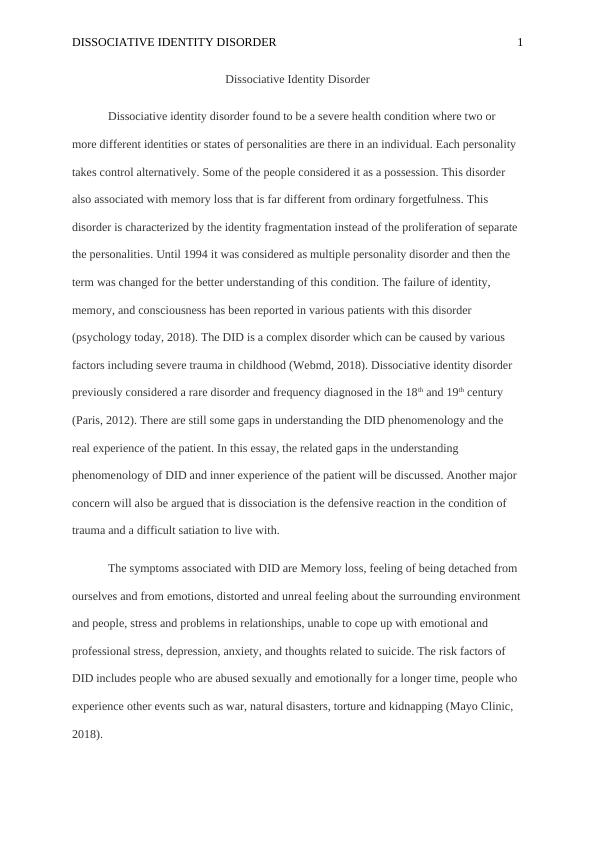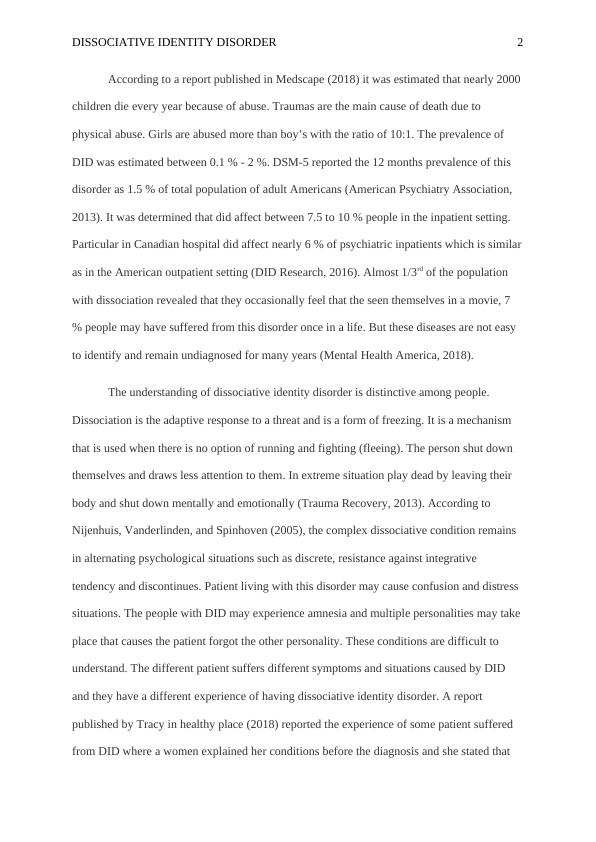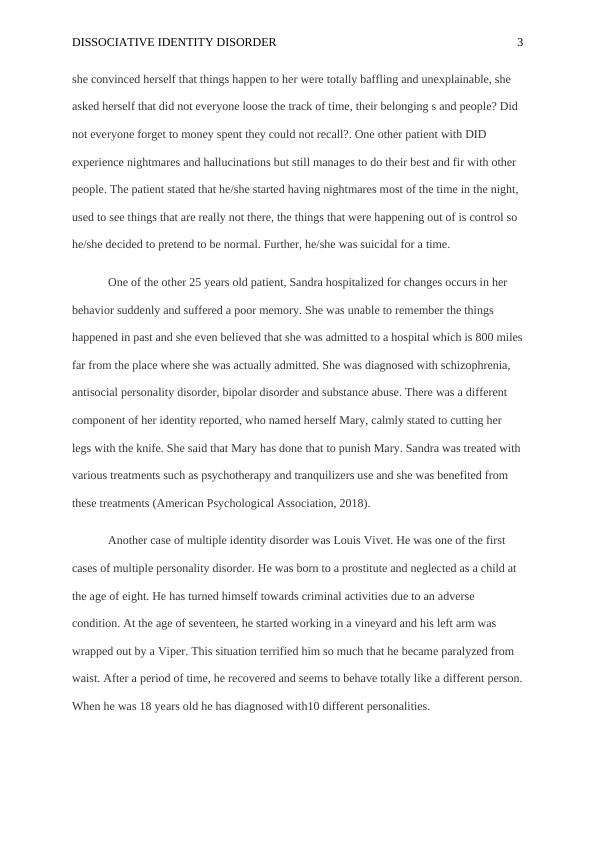Understanding Dissociative Identity Disorder: Phenomenology and Inner Experience
Added on 2023-06-10
11 Pages2812 Words484 Views
Running Head: DISSOCIATIVE IDENTITY DISORDER 0
[Date]
[Date]

DISSOCIATIVE IDENTITY DISORDER 1
Dissociative Identity Disorder
Dissociative identity disorder found to be a severe health condition where two or
more different identities or states of personalities are there in an individual. Each personality
takes control alternatively. Some of the people considered it as a possession. This disorder
also associated with memory loss that is far different from ordinary forgetfulness. This
disorder is characterized by the identity fragmentation instead of the proliferation of separate
the personalities. Until 1994 it was considered as multiple personality disorder and then the
term was changed for the better understanding of this condition. The failure of identity,
memory, and consciousness has been reported in various patients with this disorder
(psychology today, 2018). The DID is a complex disorder which can be caused by various
factors including severe trauma in childhood (Webmd, 2018). Dissociative identity disorder
previously considered a rare disorder and frequency diagnosed in the 18th and 19th century
(Paris, 2012). There are still some gaps in understanding the DID phenomenology and the
real experience of the patient. In this essay, the related gaps in the understanding
phenomenology of DID and inner experience of the patient will be discussed. Another major
concern will also be argued that is dissociation is the defensive reaction in the condition of
trauma and a difficult satiation to live with.
The symptoms associated with DID are Memory loss, feeling of being detached from
ourselves and from emotions, distorted and unreal feeling about the surrounding environment
and people, stress and problems in relationships, unable to cope up with emotional and
professional stress, depression, anxiety, and thoughts related to suicide. The risk factors of
DID includes people who are abused sexually and emotionally for a longer time, people who
experience other events such as war, natural disasters, torture and kidnapping (Mayo Clinic,
2018).
Dissociative Identity Disorder
Dissociative identity disorder found to be a severe health condition where two or
more different identities or states of personalities are there in an individual. Each personality
takes control alternatively. Some of the people considered it as a possession. This disorder
also associated with memory loss that is far different from ordinary forgetfulness. This
disorder is characterized by the identity fragmentation instead of the proliferation of separate
the personalities. Until 1994 it was considered as multiple personality disorder and then the
term was changed for the better understanding of this condition. The failure of identity,
memory, and consciousness has been reported in various patients with this disorder
(psychology today, 2018). The DID is a complex disorder which can be caused by various
factors including severe trauma in childhood (Webmd, 2018). Dissociative identity disorder
previously considered a rare disorder and frequency diagnosed in the 18th and 19th century
(Paris, 2012). There are still some gaps in understanding the DID phenomenology and the
real experience of the patient. In this essay, the related gaps in the understanding
phenomenology of DID and inner experience of the patient will be discussed. Another major
concern will also be argued that is dissociation is the defensive reaction in the condition of
trauma and a difficult satiation to live with.
The symptoms associated with DID are Memory loss, feeling of being detached from
ourselves and from emotions, distorted and unreal feeling about the surrounding environment
and people, stress and problems in relationships, unable to cope up with emotional and
professional stress, depression, anxiety, and thoughts related to suicide. The risk factors of
DID includes people who are abused sexually and emotionally for a longer time, people who
experience other events such as war, natural disasters, torture and kidnapping (Mayo Clinic,
2018).

DISSOCIATIVE IDENTITY DISORDER 2
According to a report published in Medscape (2018) it was estimated that nearly 2000
children die every year because of abuse. Traumas are the main cause of death due to
physical abuse. Girls are abused more than boy’s with the ratio of 10:1. The prevalence of
DID was estimated between 0.1 % - 2 %. DSM-5 reported the 12 months prevalence of this
disorder as 1.5 % of total population of adult Americans (American Psychiatry Association,
2013). It was determined that did affect between 7.5 to 10 % people in the inpatient setting.
Particular in Canadian hospital did affect nearly 6 % of psychiatric inpatients which is similar
as in the American outpatient setting (DID Research, 2016). Almost 1/3rd of the population
with dissociation revealed that they occasionally feel that the seen themselves in a movie, 7
% people may have suffered from this disorder once in a life. But these diseases are not easy
to identify and remain undiagnosed for many years (Mental Health America, 2018).
The understanding of dissociative identity disorder is distinctive among people.
Dissociation is the adaptive response to a threat and is a form of freezing. It is a mechanism
that is used when there is no option of running and fighting (fleeing). The person shut down
themselves and draws less attention to them. In extreme situation play dead by leaving their
body and shut down mentally and emotionally (Trauma Recovery, 2013). According to
Nijenhuis, Vanderlinden, and Spinhoven (2005), the complex dissociative condition remains
in alternating psychological situations such as discrete, resistance against integrative
tendency and discontinues. Patient living with this disorder may cause confusion and distress
situations. The people with DID may experience amnesia and multiple personalities may take
place that causes the patient forgot the other personality. These conditions are difficult to
understand. The different patient suffers different symptoms and situations caused by DID
and they have a different experience of having dissociative identity disorder. A report
published by Tracy in healthy place (2018) reported the experience of some patient suffered
from DID where a women explained her conditions before the diagnosis and she stated that
According to a report published in Medscape (2018) it was estimated that nearly 2000
children die every year because of abuse. Traumas are the main cause of death due to
physical abuse. Girls are abused more than boy’s with the ratio of 10:1. The prevalence of
DID was estimated between 0.1 % - 2 %. DSM-5 reported the 12 months prevalence of this
disorder as 1.5 % of total population of adult Americans (American Psychiatry Association,
2013). It was determined that did affect between 7.5 to 10 % people in the inpatient setting.
Particular in Canadian hospital did affect nearly 6 % of psychiatric inpatients which is similar
as in the American outpatient setting (DID Research, 2016). Almost 1/3rd of the population
with dissociation revealed that they occasionally feel that the seen themselves in a movie, 7
% people may have suffered from this disorder once in a life. But these diseases are not easy
to identify and remain undiagnosed for many years (Mental Health America, 2018).
The understanding of dissociative identity disorder is distinctive among people.
Dissociation is the adaptive response to a threat and is a form of freezing. It is a mechanism
that is used when there is no option of running and fighting (fleeing). The person shut down
themselves and draws less attention to them. In extreme situation play dead by leaving their
body and shut down mentally and emotionally (Trauma Recovery, 2013). According to
Nijenhuis, Vanderlinden, and Spinhoven (2005), the complex dissociative condition remains
in alternating psychological situations such as discrete, resistance against integrative
tendency and discontinues. Patient living with this disorder may cause confusion and distress
situations. The people with DID may experience amnesia and multiple personalities may take
place that causes the patient forgot the other personality. These conditions are difficult to
understand. The different patient suffers different symptoms and situations caused by DID
and they have a different experience of having dissociative identity disorder. A report
published by Tracy in healthy place (2018) reported the experience of some patient suffered
from DID where a women explained her conditions before the diagnosis and she stated that

DISSOCIATIVE IDENTITY DISORDER 3
she convinced herself that things happen to her were totally baffling and unexplainable, she
asked herself that did not everyone loose the track of time, their belonging s and people? Did
not everyone forget to money spent they could not recall?. One other patient with DID
experience nightmares and hallucinations but still manages to do their best and fir with other
people. The patient stated that he/she started having nightmares most of the time in the night,
used to see things that are really not there, the things that were happening out of is control so
he/she decided to pretend to be normal. Further, he/she was suicidal for a time.
One of the other 25 years old patient, Sandra hospitalized for changes occurs in her
behavior suddenly and suffered a poor memory. She was unable to remember the things
happened in past and she even believed that she was admitted to a hospital which is 800 miles
far from the place where she was actually admitted. She was diagnosed with schizophrenia,
antisocial personality disorder, bipolar disorder and substance abuse. There was a different
component of her identity reported, who named herself Mary, calmly stated to cutting her
legs with the knife. She said that Mary has done that to punish Mary. Sandra was treated with
various treatments such as psychotherapy and tranquilizers use and she was benefited from
these treatments (American Psychological Association, 2018).
Another case of multiple identity disorder was Louis Vivet. He was one of the first
cases of multiple personality disorder. He was born to a prostitute and neglected as a child at
the age of eight. He has turned himself towards criminal activities due to an adverse
condition. At the age of seventeen, he started working in a vineyard and his left arm was
wrapped out by a Viper. This situation terrified him so much that he became paralyzed from
waist. After a period of time, he recovered and seems to behave totally like a different person.
When he was 18 years old he has diagnosed with10 different personalities.
she convinced herself that things happen to her were totally baffling and unexplainable, she
asked herself that did not everyone loose the track of time, their belonging s and people? Did
not everyone forget to money spent they could not recall?. One other patient with DID
experience nightmares and hallucinations but still manages to do their best and fir with other
people. The patient stated that he/she started having nightmares most of the time in the night,
used to see things that are really not there, the things that were happening out of is control so
he/she decided to pretend to be normal. Further, he/she was suicidal for a time.
One of the other 25 years old patient, Sandra hospitalized for changes occurs in her
behavior suddenly and suffered a poor memory. She was unable to remember the things
happened in past and she even believed that she was admitted to a hospital which is 800 miles
far from the place where she was actually admitted. She was diagnosed with schizophrenia,
antisocial personality disorder, bipolar disorder and substance abuse. There was a different
component of her identity reported, who named herself Mary, calmly stated to cutting her
legs with the knife. She said that Mary has done that to punish Mary. Sandra was treated with
various treatments such as psychotherapy and tranquilizers use and she was benefited from
these treatments (American Psychological Association, 2018).
Another case of multiple identity disorder was Louis Vivet. He was one of the first
cases of multiple personality disorder. He was born to a prostitute and neglected as a child at
the age of eight. He has turned himself towards criminal activities due to an adverse
condition. At the age of seventeen, he started working in a vineyard and his left arm was
wrapped out by a Viper. This situation terrified him so much that he became paralyzed from
waist. After a period of time, he recovered and seems to behave totally like a different person.
When he was 18 years old he has diagnosed with10 different personalities.

End of preview
Want to access all the pages? Upload your documents or become a member.
Related Documents
Dissociative Identity Disorder - A Studylg...
|11
|2820
|342
Comparison of Diagnostic Criterialg...
|6
|1284
|18
Physchology Name Institution Professor Course Date.lg...
|12
|2632
|93
Dissociative Identity Disorder and Psychosomatic Conditionslg...
|9
|2622
|81
Psychopathology: Understanding and Treating Psychological Disorderslg...
|15
|890
|165
Trauma Patient: Prevalence, Pathophysiology, and Trauma-Informed Carelg...
|11
|3072
|135
